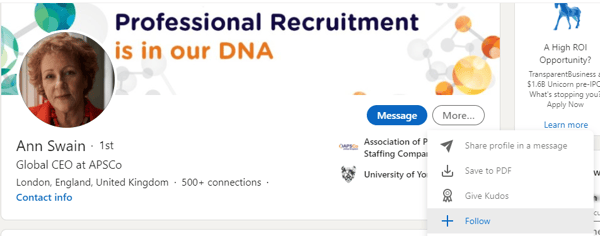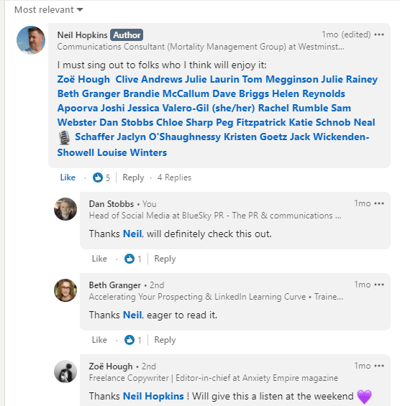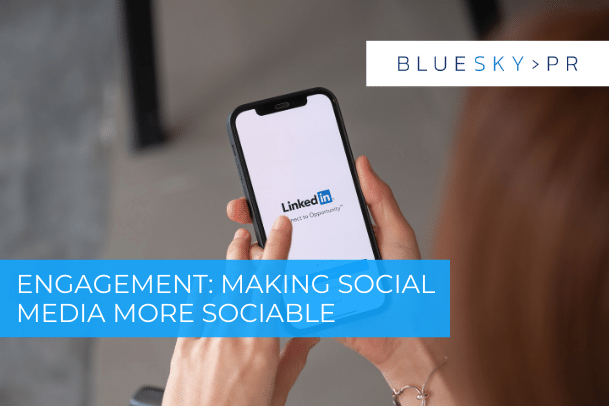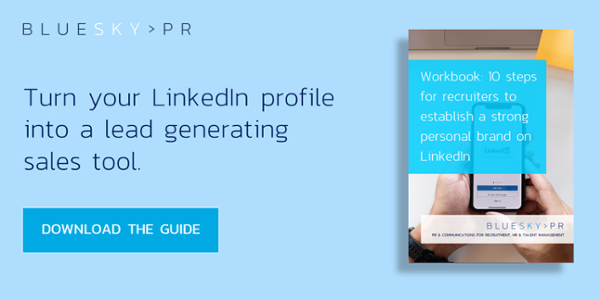With the shift to working from home as a result of the coronavirus pandemic, social recruiting has become far more competitive as recruiters look to stand out on the LinkedIn feeds of potential clients and candidates.
So how can you create meaningful engagement with prospects on LinkedIn? Here are three simple methods that recruiters can use to increase their engagement on the platform.
How recruiters can boost their engagement on LinkedIn
1. Write personalised connection requests
One of the biggest bugbears that potential candidates and clients experience on LinkedIn is receiving connection requests with either no message or a generic copy and paste message which isn’t personalised to the individual.
The best way to develop tailored connection requests is to start following them first for a few days so that you can see their posts and any content shared by them in your feed.
Following can be a great way to gather insights about a potential candidate or client so that you have something highly relevant to mention when sending them a connection request. A personalised invitation with a positive comment can help make an impactful first impression and help you stand out from the generic ‘Hi, I am currently recruiting for a [insert job title]. Would this be of interest to you?’ or ‘Hi, I’d like to join your LinkedIn network’ messages that clog up our inboxes on a regular basis.
There are two ways to follow someone on their LinkedIn profile page. They will either have a blue Follow button instead of a Connect one if they have set it up as their default call-to-action method, or you will need to click the More… button and select Follow from the drop-down menu. The user will then receive a notification that you have started following them. Although it’s unlikely you would reach the limit, it’s important to be aware that LinkedIn users are able to follow up to 5,000 people who aren’t connections.

Top Tip: LinkedIn has a 300-character limit for connection requests so it’s important that your message is clear and succinct. Rather than going in for the hard sell you should let them know why they would benefit from your connection and tailor this using information you have found from their profile or posts. Including a question in your message will also increase the likelihood of response. And don't forget, LinkedIn has a 100 a week limit on sending connection requests, and it is recommended that you don't send more than 20 a day to avoid being penalised.
2: Share relevant content and invite conversation
As a recruiter it’s important to consistently appear in the feeds of new and existing users to ensure that you stay top of mind. Reportedly only 1% of users share content on LinkedIn, so by posting you are giving yourself an advantage over 99% of users.
The best way to do this is to take notice of what’s happening in the sectors you specialise in and publish content in response to this. BUT instead of simply sharing a news story on the platform, you should add your professional opinion to enhance your personal brand and develop yourself as an expert in your field. For example, if you are sharing an article which looks at the top skills that professionals need in the next decade, why not outline what you’re currently seeing in the market? This is not only a great way of showcasing your insights but is also likely to generate engagement from your connections and even those outside of your network.
By adding a question at the end of your post you are going to increase the chances of the engagement made being comments. People love to share their opinions on social media, and by posing a question you are inviting your network to participate and share their own thoughts and experiences.
Top Tip: Make sure the questions you ask are open-ended. Closed questions limit the ability to leave a noteworthy comment and it will make it more difficult to generate engagement.
You should also respond to every comment you receive on a post. Whether that’s acknowledging them with a simple ‘like’ or short response, or by asking another question to try and further the conversation. This will indicate to the algorithm that the post and its responses are continuing to generate engagement and therefore will increase the views it receives.
3. Tag in relevant people or businesses to ask for their insight
When you post content on LinkedIn you can tag in people and companies within the text, as well as tag people in images. Tagging key people in your content can be an effective way to generate engagement and get them commenting on your post.
However, you should only tag people who are likely to have a genuine interest in the content and are likely to participate in the conversation. This is because if a number of tagged users either fail to respond or untag themselves the LinkedIn algorithm will look at the post as spam and punish it by pushing it further down users’ feeds making it difficult to come across and therefore receive less views.
To tag people or companies in your LinkedIn post, type @ and then begin typing their name. You’ll see a drop-down list appear of potential individuals and organisations matching what you have typed in. Click the name of the member or company you want to mention and then continue typing your post.
To tag someone in an image in your LinkedIn post, click the Photo icon in the Start Post box and choose which image or images you’d like to upload.
Click anywhere on the photo and start typing the name of the LinkedIn member you want to tag. A drop-down menu will appear where you can select their name to add their tag. LinkedIn allows you to tag up to 30 people per photo.

Top Tip: When tagging individuals or companies in your posts think about how relevant the content is for them and if they would add something meaningful to the conversation. For example, you could tag colleagues to get their insights or clients and successfully placed candidates to get views directly from the sector.
Focusing your efforts into producing posts that generate meaningful conversation will help you increase your LinkedIn engagement and be seen in the feeds of your connections and those outside of your network too. This will provide you with opportunities to build and nurture relationships that can turn into new clients and candidates.
Originally published January 2021, updated April 2022



